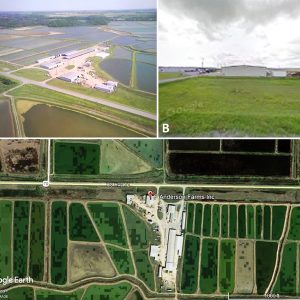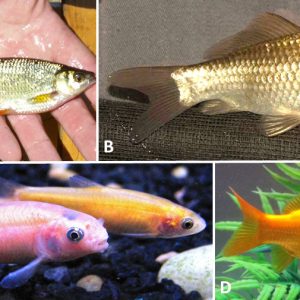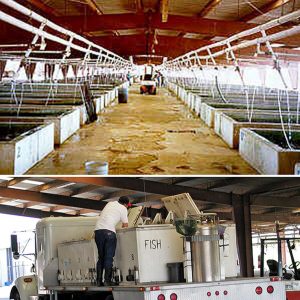calsfoundation@cals.org
I. F. Anderson Farms
aka: I. F. Anderson Minnow Farms
aka: Anderson Minnow Farm
aka: Anderson’s Minnow Farm
I. F. Anderson’s Farms, Inc., is located just west of Lonoke (Lonoke County). The farm includes about 322 kilometers (200 miles) of levees that impound 3,400 acres of ponds accessed via a “checkerboard” pattern of levee roads. It boasts as the world’s largest minnow (baitfish) farm, providing a bounty of golden shiners (Notemigonus crysoleucus). As the premier fish farm in the nation, it produces over one billion shiners each year.
The I. F. (Fay) Anderson family initially dug and stocked its first farm ponds in Lonoke in 1949. James Neal Anderson and his son Jamie Anderson are fourth-generation owners.
The 11,000-square-foot hatchery facility is capable of producing over one billion fry per season and can accommodate five million pounds of “feeder” fish annually. Millions of golden shiner fry are shipped during April and May to private pond owners and fishery managers. While consumers can purchase adult forage fish, Anderson also sells two- and three-day-old fry at a much higher head count and at a much lower price.
When the fry are released into a pond after hatching, they begin feeding on zooplankton, rotifers, and miscellaneous aquatic biota that are present inside the watershed. Golden shiner fry are brought into the facility as eggs harvested from their minnow ponds at I. F. Anderson’s hatchery. Once hatching has taken place, they are put in specialized bags filled with oxygen. These bags are then placed into heavy cardboard containers with insulated liners and shipped overnight to their clients.
The farm belongs to and supports the Arkansas Baitfish and Ornamental Growers Association. The association has a certification program designed to provide high-quality, farm-raised bait and ornamental fish, free of certain diseases, undesirable plants and animals, and other contaminates considered injurious to fish or fisheries. Therefore, due to concern about diseases in fisheries in the northern United States, Anderson’s ensures that the baitfish they raise and ship are free of pathogens, including viruses like VHS (viral hemorrhagic septisemia), IHN (infectious hematopoietic necrosis virus), SVCV (spring viremia of carp), and IPN (infectious pancreatic necrosis virus), as well as other infections, and even undesirable by-catch biota. With this program, farm biosecurity is inspected by the U.S. Department of Agriculture Animal and Plant Health Inspection Service (USDA-APHIS), and fish are examined semi-annually under the supervision of a USDA-certified veterinarian. Fish are submitted for examination to a testing lab where they are also inspected under USDA-APHIS approved protocols, with results going directly to the USDA. The farm also conducts other farm-level inspections to help meet interstate regulations. It samples for several viruses and conducts inspections for other diseases such as furunculosis (Aeromonas salmonicida), enteric redmouth disease (Yersinia ruckeri), and heterosporis (a microsporidian). I. F. Anderson Farms is certified under the Arkansas Bait and Ornamental Fish Certification Program.
Many years of intensive scientifically developed field experiments produced I. F. Anderson Farm’s patented creation, the black salty (a gold-silver goldfish). It is a very hardy, saltwater-tolerant breed that has been termed “the ultimate live bait” for both freshwater and saltwater fishing. For use in freshwater fishing, the black salty is a highly effective and established baitfish for various predatory fishes, including largemouth bass (Micropterus salmoides), striped bass (Morone saxatilis), hybrid stripers, catfish, and other gamefishes. In offshore areas in the Gulf of Mexico and the Atlantic Ocean, several marine fishes including cobia (Rachycentron canadum), mahi-mahi (Coryphaena hippurus), king mackerel (Scomberomorus cavalla), northern red snapper (Lutjanus campechanus), various tuna (Thunnus spp.), and a suite of other species have been consistently caught using the black salty. In bays and estuaries, flounder (Paralichthys spp.), spotted seatrout (Cynoscion nebulosus), red drum (Sciaenops ocellatus), Spanish mackerel (Scomberomorus maculatus), various sharks, and M. saxatilis and other predators readily go for the baits using black salty.
The farm also spawns and cultivates high-quality bait and forage fish, including the rosy red (black and pink), fathead minnow (Pimephales promelas) and goldfish (Carassius auratus). The fathead minnow is a great forage species and contributes to getting farm ponds and lakes off to a crucial start as well as serving as excellent live bait. Feeder goldfish, as the name implies, are primarily used to feed larger predatory species kept in aquariums.
Interestingly, a new species of protozoan (Protoopalina allisteri) was described from an eastern narrowmouth toad (Gastrophryne carolinensis) collected on farm property. In addition, intraerythrocytic hematozoan parasites were reported from red-eared sliders (Trachemys scripta elegans) collected from farm ponds at the site.
For additional information:
Anderson Minnow Farm. http://www.andersonminnows.com/index.php (accessed April 23, 2019).
Delvinquier, Ben L. J., Sherwin S. Desser, and Jerry Johnson. “Opalinidae (Sarcomastigophora) in North American Amphibia. Genus Protoopalina Metcalf, 1918.” Systematic Parasitology 32 (1995): 141–147.
Dorman, Larry W. “Baitfish Production in Arkansas: A Historical Review.” Proceedings of the North Central Aquaculture Conference 91 (1991): 231–236.
Goodwin, Andy, and Nathan Stone. “Arkansas Bait and Ornamental Fish Certification Program Developed.” Arkansas Aquafarming 24 (2007): 1.
McAllister, Chris T., and Anthony W. King. “Hemogregarines in the Red-Eared Slider, Chrysemys scripta elegans (Wied) from Arkansas.” Proceedings of the Arkansas Academy of Science 34 (1980): 124. Online at http://scholarworks.uark.edu/cgi/viewcontent.cgi?article=2677&context=jaas (accessed April 23, 2019).
Chris T. McAllister
Eastern Oklahoma State College










Comments
No comments on this entry yet.